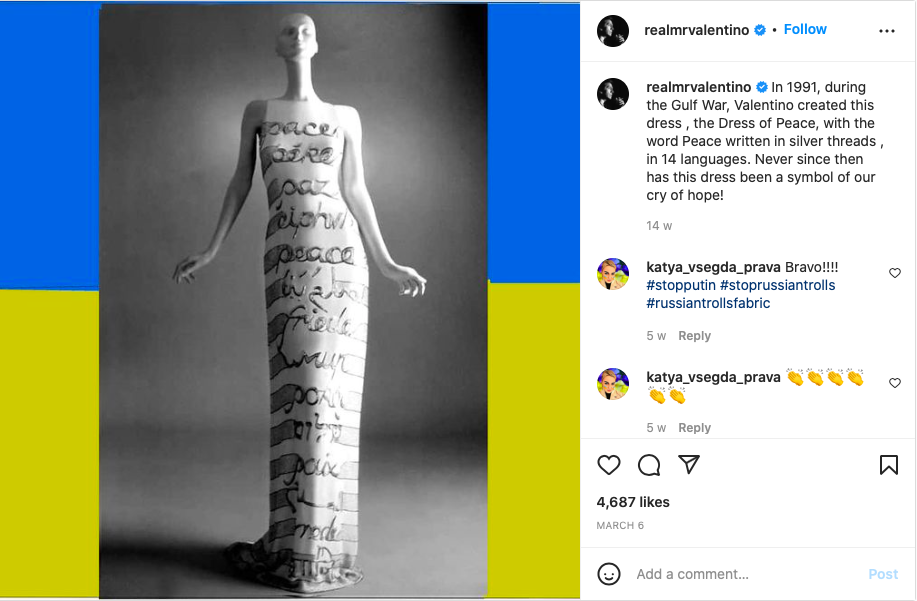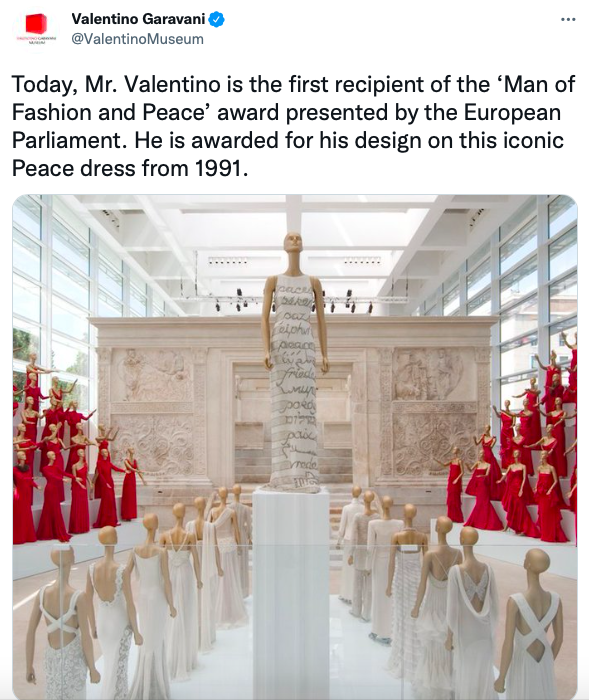Fashion designer Valentino’s Peace Dress is undoubtedly one of the most iconic symbols of peace and fashion combined. The simple long white gown is made unique by the silver writing that covers it, with the word ‘peace’ stitched in fourteen different languages across the front of the dress. While the dress was originally created as a comment on the Gulf War in 1991, the message of this design possesses a timeless quality which has been deployed to communicate the desire for peace in more contemporary instances. Most recently, a picture of the dress has recently been reposted on Valentino’s Instagram page, with the background displaying the colours of the Ukrainian flag. As the caption cites, ‘Never since then [the Gulf War] has this dress been a symbol of our cry for hope!’

Despite its iconic status, I personally do not believe that the dress poses unique, challenging thoughts on peace visualisation. On the contrary, it arguably reinforces a narrow, stereotypical and inert view of peace. The choice of white for the dress can be ascribed to a popular (strongly Western) trend of interpreting white as a recognisable colour of peace. The idea of stitching the word ‘peace’ in fourteen different languages is also not necessarily as inclusive as might have been intended; nothing about the embroidery, the cut of the dress – long, with a jewel/bateau neckline – or the fabric indicates the merging of multiple cultures, or the awareness of diversity in unity. Instead, there is an amalgamation of all the languages in the same font and colours, which airbrushes out differences and papers over the complexities of an authentic union of cultures. Finally, the dress arguably implies that campaigning for peace simply involves calling for peace, in eye-catching, multi-lingual ways. While it is valuable to have powerful voices using their significant platforms to advocate for peace, the reality of peace campaigning is far messier and less glamorous than this dress suggests.
That said, the simplicity of this dress, and its conceptualisation of peace coming from standardised imageries, has the power to produce an emblematic and iconic message of peace precisely because it is not culturally specific or complicated. The Peace Dress has, in fact, become a staple in the fashion world, both an iconic moment amongst Valentino’s multiple fashion shows and an element of collective imagery. It shows how fashion has the power to communicate messages instantly and timelessly, as shown by the fact that this dress has reappeared on social networks multiple times across different historical moments, when a symbol of peace was needed. In this sense, fashion transcends language barriers, and it can therefore become a powerful communicative tool.
In my view, then, the Peace Dress should not be criticised for reducing peace activism to simple imagery because the dress is not, in itself, a conversation about peace but rather a trigger to start peace conversations. It does not try to be an exhaustive symbol of peace-building, but rather a call for attention which demands further discussion. While the world of fashion (that is, the people who work in fashion) has almost no boundaries in reflecting on, promoting and advocating for peace, a dress has physical limitations, in that its strict materiality cannot possibly include the multi-faceted nature of the issues it might inspire us to tackle. The Peace Dress becomes, therefore, an inspiration for discussing peace, a starting point and an emblem that is easy to reproduce; precisely what a symbol needs to be.
What do you think?
- What do you think of Valentino’s Peace Dress?
- How do iconic images of peace shape our understanding of the concept of peace as a whole? How do they inform our thinking on what peace is and our agency around it? How have we collectively constructed imageries of peace and how useful is it to perpetrate them?
- What role can fashion play in advocating for and kick-starting conversations on peace?
- If you were designing a fashion item to represent or advocate for peace, what would it be like?
If you enjoyed this item in our museum…
You might also enjoy ‘Utopia/Dystopia‘, ‘Jean Gritsfeldt, Berlin Fashion Week‘, ‘Isha Sadhguru’s “Fashion for Peace”, ‘Intergalactic Freedom Dress‘ and other items with the tag ‘Artivism‘.
Federica Consiglio, May 2022
[1] To look at the Instagram post, follow this link: https://www.instagram.com/p/CawyAy2I10f/?utm_source=ig_web_copy_link.
